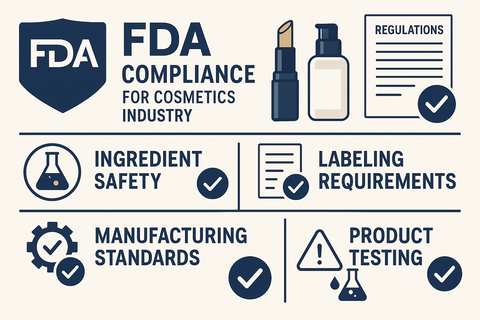The cosmetics industry follows strict FDA rules to protect consumers and keep products safe. Any cosmetic product placed on the market must follow U.S. law. This includes the Federal Food, Drug, and Cosmetic Act (FD&C Act) and the Fair Packaging and Labeling Act. The Modernization of Cosmetics Regulation Act of 2022 (MoCRA) added more rules recently. The updates include rules about registering facilities. They also include rules about listing products and reporting bad events. Following these rules lowers the risks of misbranding, adulteration, and safety problems.
Good manufacturing practices and quality control
FDA cosmetic rules focus on Good Manufacturing Practices and quality control. A facility must use clear rules to check suppliers. It must use standard tests and inspection checklists. Inspections often check forms, records access, and regulatory processes. Companies must prove the safety of every cosmetic ingredient. This includes fragrances and colors like cochineal extract. Using prohibited ingredients such as PFAS or polyfluoroalkyl substances may lead to recalls or import refusals. Strong formulation practices lower the chances of allergic reactions. They also help lower contamination.
Labeling and packaging regulations
Accurate cosmetic labeling is a core part of compliance. Labels must list ingredients, net weight, and responsible person details. Mislabeling can cause recalls. It can also cause market withdrawals or enforcement reports. The Fair Packaging and Labeling Act ensures consumers receive honest and clear information. Packaging must show information about allergens. It must also follow rules about black henna and asbestos detection. Following labeling rules helps companies follow the law and gain consumer trust.
Registration and listing requirements
MoCRA added new registration and listing duties for the cosmetics industry. Companies must now register their cosmetic product facilities. They must also list their cosmetic products. Electronic submissions, such as Form FDA 3500A, support adverse event reporting. The cosmetic registration program used to be voluntary. Now, listing products is required. Import inspections and import surveillance enforce these rules at the border. Keeping documentation in line with the Federal Food, Drug, and Cosmetic (FD&C) Act helps companies get ready for FDA inspections.
Managing adverse events and recalls
Compliance continues after a product reaches the market. Adverse event reporting helps the FDA track safety concerns. Failure to report may lead to FDA recall policy actions or mandatory recall authority. Serious adverse event forms and FDA US agent notifications are often required. Companies must prepare for market withdrawals if problems happen. They must also prepare for recalls or enforcement reports. Ingredient safety testing, such as asbestos detection, reduces risks. Keeping accurate records allows quick action if product safety concerns arise.
Educational steps toward compliance
To follow FDA cosmetic regulations, companies can focus on these five steps:
- Apply Good Manufacturing Practices across all facilities.
- Test cosmetic ingredients with standardized testing methods.
- Register facilities and products as required under MoCRA.
- Follow cosmetic labeling rules from FDA guidance documents.
- Prepare for inspections, recalls, and regulatory processes.
Building long-term compliance strategies
The FDA requires companies to keep following cosmetic rules. Companies must regularly check their formulas, packaging, and suppliers. Guidance documents and the Federal Register explain key rules for cosmetics. Rules such as the Microbead-Free Waters Act of 2015 also affect product development. The FDA enforces compliance through inspections, enforcement reports, and import actions. Following these rules supports safety, consumer trust, and the growth of the U.S. cosmetics industry.
If you are ready to create your next cosmetic product, please contact us to get started.
